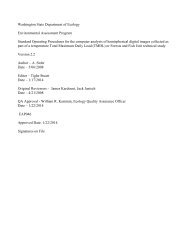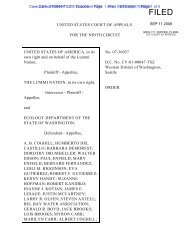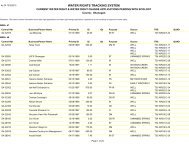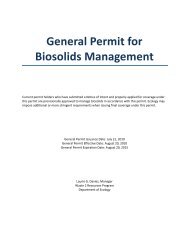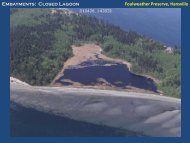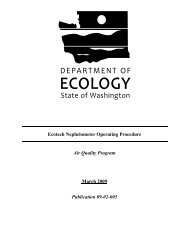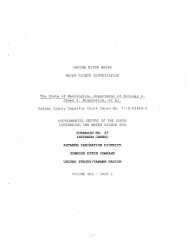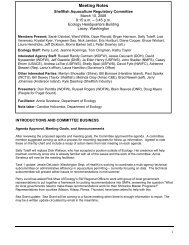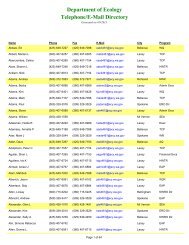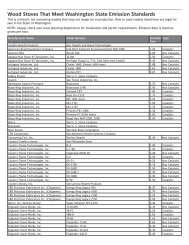WRIA 62 WMP 032305 - Washington State Department of Ecology
WRIA 62 WMP 032305 - Washington State Department of Ecology
WRIA 62 WMP 032305 - Washington State Department of Ecology
You also want an ePaper? Increase the reach of your titles
YUMPU automatically turns print PDFs into web optimized ePapers that Google loves.
March, 2005 -88- 023-1289-003.3040<br />
In the second part <strong>of</strong> the process, a sub-basin assessment is conducted to determine pollutant sources<br />
in the 303(d) listed waters, and IDEQ gathers additional data to supplement the initial assessment.<br />
After this period <strong>of</strong> further study, the water body is de-listed (if beneficial uses are not impaired), or a<br />
TMDL is developed to restore the impaired water body.<br />
In Idaho, when a sampling station deems a stream impaired, all locations upstream in the watershed<br />
are also considered impaired. Therefore, if a fourth order stream location is found to be impaired, all<br />
fourth order streams in the watershed would be listed as impaired. If a first order stream is considered<br />
impaired, a TMDL would be needed for the entire watershed. This differs from <strong>Washington</strong> where a<br />
stream is listed on the 303(d) within the section <strong>of</strong> a township and range where the sample(s)<br />
indicating the exceedance was taken.<br />
Water quality impairments in the Pend Oreille drainage in Idaho include temperature, sediment,<br />
dissolved oxygen, total dissolved gas, and pathogens. The 1998 and draft 2000/2003 303(d) listed<br />
waterbodies are illustrated on Figure 4-7 and 4-8.<br />
5.2.4 TMDLs in Idaho<br />
There are currently six approved sediment TMDLs and one approved temperature TMDL in streams<br />
within the Priest River watershed that have the potential to impact water quality downstream in<br />
<strong>WRIA</strong> <strong>62</strong> (Figure 4-6 and Table 4-6). These TMDLs are:<br />
• Sediment for Reeder Creek, Kalispel Creek, Binarch Creek, Lower West Branch Priest<br />
River, the East River watershed and the Lower Priest River; and,<br />
• Temperature for the East River watershed.<br />
In addition, the following TMDLs are planned in the near future:<br />
• Temperature for Hughes Fork, Granite Creek, Reeder Creek, Kalispel Creek, Binarch<br />
Creek, Lower West Branch Priest River and the Lower Priest River; and,<br />
• Sediment, temperature and total dissolved gas for the Pend Oreille River (from Lake<br />
Pend Oreille to the <strong>Washington</strong> – Idaho border).<br />
The total dissolved gas (TDG) issues for the Clark Fork - Pend Oreille system in Idaho are primarily<br />
being addressed, at the current time, through implementation <strong>of</strong> the Gas Supersaturation Control<br />
Program for the Clark Fork Project (Avista, 2004). This TDG program focuses on operations <strong>of</strong> the<br />
Cabinet Gorge Hydroelectric Development, eight miles upstream <strong>of</strong> Pend Oreille Lake. In 2005,<br />
Idaho DEQ will initiate a sub-basin assessment and TMDL effort for the Pend Oreille River. TDG<br />
issues will be examined as they pertain to the Albeni Falls Hydroelectric Project and river conditio ns<br />
between Albeni Falls and the Idaho - <strong>Washington</strong> state line.<br />
<strong>WRIA</strong> <strong>62</strong> <strong>WMP</strong> <strong>032305</strong>



